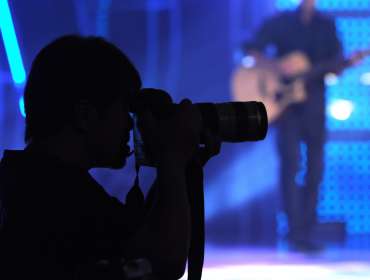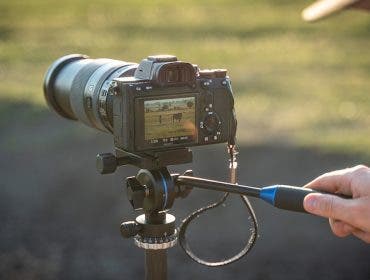When photographers purchase a new camera, the viewfinder usually isn’t the first thing that comes to mind in their search. However, the viewfinder plays a very important role in the photographic process, since you’ll likely be using it on almost every photo you take. Traditionally, cameras have always had optical viewfinders, where looking through the viewfinder will show you exactly what you’re looking at. Now, some cameras are made with electronic viewfinders (EVF), which have a lot more features and capabilities. In this post, we’ll be learning all about EVFs and deciding if you should pick up a camera that has one.
What is an EVF?
An EVF — otherwise known as an electronic viewfinder — is a feature on mirrorless cameras that allows you to look through the viewfinder and see the image you are about to take. Light hits the sensor, which quickly records data in real time and shows you a preview of the image you are about to take on the camera’s viewfinder or LCD screen. The preview you will see will change and update in real time as you move the camera or adjust the settings before you take the photo. If you have a DSLR camera, this is very similar to the preview you will see when shooting in Live View mode.
Read more about these types of cameras at Mirrorless vs DSLRs: How Do They Compare?
While many DSLR cameras have Live View mode, this is only visible on the camera screen. Looking through the viewfinder will not show Live View. A camera with an electronic viewfinder will allow you to look through the viewfinder to see the live view image. This is very beneficial at times, since the viewfinder is shaded and can be seen much easier than the camera screen, especially when outside or under bright light. Not only can you use the Live View in the viewfinder, but you can also use image review or browse the camera menu as well.

OVF vs. EVF
An optical viewfinder (OVF) is the viewfinder that you would see on a DSLR or film camera. When you look through the viewfinder, you see the scene in front of you — no matter what settings you choose on the camera. It is not digital, so you will see the scene in front of you as it is.
Since it isn’t digital, an OVF doesn’t use any battery when you use it. It is simply showing you the scene reflected on your camera’s sensor. An EVF is digital, so you will generally not get as long of a battery life on a camera with an EVF.
Pros of an EVF
However, having an EVF comes with many benefits that photographers will find very useful. First, it is much easier to see a dimly lit scene on an EVF since the viewfinder is illuminated. This makes shooting at dawn and dusk much easier. Since the viewfinder is illuminated, it is also much easier to review images and adjust camera settings through the viewfinder. This is especially true on a bright sunny day when you may struggle to see the back of the camera.
Next, you can see the live preview of the image you are about to take. This means it can be much faster and easier to dial in the proper settings for your exposure before you take it. When using an OVF, the only way you can dial in the exposure is by using the meter, rather than seeing the live preview of your image on an EVF.
Another benefit of an electronic viewfinder for on-the-go photographers is that you see the images you take immediately after shooting the photo on the viewfinder. This can help you make quick adjustments in the field to capture the perfect image.
Lastly, having an EVF unlocks many features that photographers may find helpful while out shooting. Focus peaking and focus assist zoom both allow you to dial in the manual mode of your lens easier than ever before. These are invaluable features that are only available on an electronic viewfinder.
How to Choose between EVF and OVF
Choosing between an EVF and OVF mostly comes down to preference. EVFs are certainly more advanced, and have access to more features to help photographers in the field. However, many photographers don’t like the feel of the live display as they move the camera around and prefer the more traditional OVF. While the battery life of EVF cameras has drastically improved over the last few years, OVF cameras will still be the choice of camera for photographers worried about running out of battery. Both EVF and OVF cameras have their strengths and weaknesses, and the choice ultimately comes down to your personal preference and desired use.
Cameras with EVFs
Fujifilm X-T4 Mirrorless Digital Camera
The Fujifilm X-T4 is a crop sensor camera with great capabilities for both photo and video. The X-T4 also comes with a flip-out screen and the capability to shoot 4k video at 60 frames per second.
Nikon Z 7II Mirrorless Digital Camera
The 47.5 megapixel Nikon Z 7II is a mirrorless camera capable of ultra fast buffer speeds for continuous shooting as well as excellent low-light autofocus performance. The Nikon Z 7II also has Nikon’s excellent eye detection autofocus, which is sure to be a sought after feature for portrait photography.
Sony Alpha a6600 Mirrorless Digital Camera
The Sony a6600 is the perfect travel size mirrorless camera that doesn’t forfeit quality for size. This small, crop-sensor camera boasts a 24.2 megapixel sensor and can shoot in continuous mode up to 11 frames per second.
Canon EOS R Full-Frame Mirrorless Digital Camera
Canon’s EOS R is their full frame version of a mirrorless camera, which is much smaller and more packable than many DSLRs on the market today. With 30.3 megapixels, you’ll be able to capture stunning detail and definition in your photos with the EOS R.
Panasonic Lumix DMC-G7 Mirrorless Camera
New photographers or those that want a very easy-to -use camera that doesn’t sacrifice quality will love the Lumix DMC-G7. This camera offers great value in a small camera that takes great photos. If you’re new to photography, don’t overlook the Panasonic Lumix DMC-G7.
Olympus OM-D E-M1 Mark III Camera
The Olympus OM-D E-M1 Mark III is a great mirrorless camera for the on-the-go photographer. It offers 7.5 stops of shutter speed stabilization to make sure that your handheld photos aren’t blurry. It also has the ability to take high resolution handheld or tripod photos. This is all packaged into a lightweight and compact body.
All things considered, there is a lot to think about when buying a new camera. Both EVF and OVF viewfinders have their pros and cons. It’s important to decide which one will work best for you and your desired uses. It’s definitely worth considering picking up a camera with an electronic viewfinder, even for those who are used to shooting on an optical viewfinder. The change will take some time to get used to, but it is worth it in the long run.






